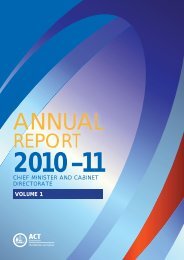HSR Training Programs Guidelines [ PDF 191KB]
HSR Training Programs Guidelines [ PDF 191KB]
HSR Training Programs Guidelines [ PDF 191KB]
You also want an ePaper? Increase the reach of your titles
YUMPU automatically turns print PDFs into web optimized ePapers that Google loves.
OCCUPATIONALHEALTH AND SAFETYCOUNCILREVISED GUIDELINES FOR THE APPROVALOF HEALTH AND SAFETY REPRESENTATIVETRAINING PROGRAMSAugust 2006SecretariatACT Occupational Health and Safety CouncilC/- Office of Industrial RelationsACT Chief Minister’s DepartmentGPO Box 158Canberra ACT 2601
ACT OCCUPATIONAL HEALTHAND SAFETY COUNCILREVISED GUIDELINES FOR THE APPROVAL OF OCCUPATIONAL HEALTHAND SAFETY REPRESENTATIVE TRAINING PROGRAMSINTRODUCTIONThe Occupational Health and Safety Act 1989 (the Act) provides a statutory framework forpromoting and improving the standards of occupational health, safety and welfare of privatesector and ACT public sector employees in the ACT. Health and safety representatives(<strong>HSR</strong>s) are central to workplace arrangements established under the Act for consultation,representation and participation in at the workplace in relation to work safety.Section 61(1)(f) of the Occupational Health and Safety Act 1989 (OHS Act) provides thatemployers shall permit health and safety representatives (<strong>HSR</strong>s) to take time off workwithout loss of remuneration or other entitlements to undertake a training programapproved under the Regulations. Section 60A of the Act as modified by Schedule 3 of thePublic Sector Management Act 1994 in relation to the ACT Public Service provides that <strong>HSR</strong>sshall undertake a course of training approved under the Regulations. Similar provisionsapply to deputy health and safety representatives.The OHS Act was amended in June 2004 to provide rights-of-entry to workplaces forauthorised representatives of organisations. Under section 75(2)(b) of the new provisions, arepresentative must have completed a course of training approved under the regulationsbefore being authorised. An approved course of training for <strong>HSR</strong>s has been prescribedunder section 3 of the Occupational Health and Safety Regulation 1991 as necessary forauthorisation.Part 2, section 3 provides that the Council may approve a program for the purposes of <strong>HSR</strong>training. To meet its responsibility under part 2, the Council has issued these guidelinessetting out the process of approval for a program of training for <strong>HSR</strong>s and authorisedrepresentatives in the ACT. The guidelines provide information on the application andassessment process, and direct potential applicants to sources of further information to aidin the development of an application.When considering a request to approve or reapprove a training course for <strong>HSR</strong>s, the Councilwill accept applications for the approval of training programs for <strong>HSR</strong>s from trainingorganisations that meet the requirements set out in these guidelines. The Council may takeinto consideration policy issues when determining approvals, for example, nationalconsistency and developments, national standards and industry best practice, tripartitesupport and any other relevant matter.Additional copies of these guidelines are available through the Council secretariat (c/- theOffice of Industrial Relations) or the Office website at:http://www.psm.act.gov.au/ohscouncil.htm2
TABLE OF CONTENTSIntroduction..................................................................................2Overview of the Application Process .......................................4Registration as a <strong>Training</strong> Organisation (RTO).......................5Program Accreditation ................................................................5<strong>Training</strong> Qualifications................................................................5Criteria for Approval ...................................................................5Course Content ............................................................................6Application Format....................................................................12Notification & Review of Decisions .......................................14Conditions of Approval ............................................................14Further Information ..................................................................153
OVERVIEW OF THE APPLICATION PROCESSSTEP ONE: SUBMISSION OF A WRITTEN APPLICATIONYou must submit a detailed written application with appropriate supporting evidence thataddresses the approval criteria set out in the guidelines. If you propose to deliver training toa specific industry or occupational grouping, this should be made clear in your applicationand be appropriately reflected in your proposed program documents. All applications mustinclude copies of educational qualifications and/or other supporting evidence detailingrelevant learning and experience. You must provide six (6) complete sets of your applicationand supporting documentation.Upon receipt of an application for approval, the Council will send you an acknowledgmentslip stating the date the application was received and a contact name and phone numbershould you require information regarding progress of the application. All applicants will benotified about the outcome of the Council’s determination within three (3) calendar monthsof receipt of the application.STEP TWO: ASSESSMENT PANELOnce your application is received, it will be scheduled for review by an assessment panel.You may be asked to attend a session of the assessment panel to respond to questionsconcerning your application including your course materials and methods.The assessment will be made in accordance with the Council’s agreed guidelines. The panelwill determine whether the application should be recommended to the Council for approval.If additional documentation is required before the panel can make a full assessment, you maybe asked to provide it to enable the application to be properly assessed. Applicants shouldnote that if additional documentation is required, it may cause a delay in the processing oftheir application.STEP THREE: APPROVAL BY COUNCILFollowing the assessment by the panel, its recommendation will be forwarded to the OHSCouncil for consideration. Once the Council has considered the recommendation, theapplicant will be notified in writing of the outcome. Approvals will be for a period of three(3) years. To be reapproved, you must submit an application at least three (3) months beforethe current approval expires. You will not be able to deliver training if your program’sapproval expires and has not been reapproved.4
REGISTRATION AS A TRAINING ORGANISATION (RTO)The OHS Council requires that all providers be Registered <strong>Training</strong>Organisations (RTOs).In the ACT, the process for registering is managed by the ACT Accreditationand Registration Council (ARC). This registration process recognises trainingorganisations which have the capacity to deliver, assess, and issue qualificationsfor nationally recognised training. As part of this application, a trainingorganisation must demonstrate compliance with the Standards from theAustralian Quality <strong>Training</strong> Framework (AQTF) which was adopted nationallyby all states in June 2001.Further information on the registration of training organisations can berequested from the ACT Accreditation and Registration Council.PROGRAM ACCREDITATIONThe Council has put in place processes to move to the accreditation of programsin line with the AQTF processes for course accreditation. Within three (3) yearsof the Council’s approval, a provider is required to accredit the program forinclusion in the organisation’s scope of registration.TRAINING QUALIFICATIONSThe Council requires approved programs to be delivered by trainers who holdqualifications consistent with the AQTF Standard 7 in relation to assessment andworkplace training. Where courses are not accredited, Council requires approvedprograms to be delivered by trainers who hold a minimum qualification of aCertificate III in Occupational Health and Safety or recognition by anappropriate training organisation of prior learning/experience equivalent to aCertificate III in Occupational Health and Safety.CRITERIA FOR APPROVALApplications will be assessed based on the following conditions:• evidence of registration as a Registered <strong>Training</strong> Organisation (RTO);5
• course content which successfully meets the required criteria set out in theseguidelines; and• evidence of course accreditation or, for courses which are not accredited, evidence oftrainer qualifications at the minimum level of Certificate III in Occupational Healthand Safety or recognition by an appropriate training organisation of priorlearning/experience equivalent to a Certificate III in Occupational Health and Safety.COURSE CONTENTThe OHS Council ensures that all programs meet the content required under the guidelines.The course design must meet the delivery conditions listed below.The course must:• Be flexible in its delivery options. Delivery should indicate an assessment of theneeds of the participants and encompass flexibility as well as block training and/orsole reliance on classroom learning. The Council encourages flexibility in deliverymodes to take into account adult learning needs, and out-of-classroom learningmethods, for example, project work to support formal training on prescribed topics.• Have a minimum duration of 28 hours in order to ensure sufficient time toadequately cover the course content. The course should be delivered over a periodof no more than eight (8) weeks to ensure maximum effectiveness. (It should benoted that where operational requirements of the employer prevent this from beingmet, the trainer may give approval for a further four (4) weeks for completion of thecourse. This decision must be made on an individual case by case basis and specificdetails must be included in the annual returns submitted by the approved trainer)• Attach a module of no less than seven (7) hours to act as a refresher course suitablefor the training of <strong>HSR</strong>s at the end of the second year of their term or for re-elected<strong>HSR</strong>s. The contents of the refresher course should focus on the provision ofopportunities for existing <strong>HSR</strong>s to refresh the basic knowledge and skills of theoriginal training, as well as providing an update of the legislative, regulatory and skillsbased information since the basic training was undertaken.• Provide all participants with certificates of participation. The Council recognises that<strong>HSR</strong>s are elected by their co-workers to perform this role. Accordingly, it is notappropriate to treat skills/knowledge required by occupational health and safetyrepresentatives as formal competencies, although the merits of competency-basedtraining as a training method are recognised.• Include a system of feedback and evaluation mechanisms that are commutable to aquality assurance program.• Utilise training methods that are suitable for people from a non-English-speakingbackground. The training methods should also incorporate a competency approachwhich balances theory and practical activities.6
The key performance indicators for a successful program include:• the provision of knowledge and skills so that participants can apply principles of riskmanagement as an integral part of an effective OHS management system;• the provision of detailed information about ACT OHS legislation and a summaryintroduction to workers compensation arrangements (including workplace injurymanagement) to the participants; and• the provision of training which supports the development of skills and confidence toenable employees to effectively participate in the prevention of workplace injuriesand illnesses.It should be noted that the following list is not exclusive, and the OHS Council maintainsthe right to request additional information be included based on changes in Territorylegislation or regulations.INITIAL COURSE OUTLINECONTENTBACKGROUND TO OHSPERFORMANCE CRITERIA• Outline the development of OHS legislation andpractices in Australia including the modern approachto the management of workplace safety and relatedissuesOHS AND RELATED LEGISLATION • Explain the Occupational Health and Safety Act 1989and related work and safety legislation (such as theScaffolding and Lifts Act 1912, the Machinery Act 1949,and the Dangerous Substances Act 2000) as well asaward and agreement provisions• Provide summary information on the Crimes(Industrial Manslaughter) Act 2003• Provide a summary information on the WorkersCompensation Act 1951 and/or the Safety, Rehabilitationand Compensation Act 1988, and on occupationalrehabilitation• Provide information about and examples of OHSrelevant policies, programs, and procedures7
CONTENTWORKPLACE HEALTH AND SAFETYARRANGEMENTSPERFORMANCE CRITERIA• Identify the roles and duties of employers,supervisors, employees, health and safetyrepresentatives and unions• Outline the role of OHS inspectors• Explain workplace arrangements for OHSCommittees, establishment of Designated WorkGroups (DWGs), election of <strong>HSR</strong>s, meetingprocedures and records• Explain the provisions for authorised representativesand rights to enter workplacesHEALTH AND SAFETYREPRESENTATIVES• Explain the powers and responsibilities of <strong>HSR</strong>s• Explain the purpose of conducting workplaceinspections and accident/incident investigations• Provide information on the purpose and use ofProvisional Improvement Notices (PINs), and theroles of OHS inspectors in relation to review ofPINs• Provide information on emergency procedures andprocesses for consultation and cessation of work inemergency situationsOHS CONSULTATION• Identify methods of consulting and negotiating withan employer on implementing corrective actions• Outline the process of communication and teachbasic communication skills• Explain dispute resolution procedures• Demonstrate conflict scenarios• Develop negotiating skillsHAZARD IDENTIFICATION AND RISKMANAGEMENT• Outline the process of hazard identification, riskassessment and development of risk controlmethods, including the Hierarchy of Controls andthe development and implementation of safe workmethods• Develop an understanding of the applications ofCodes of Practice and relevant OHS policies withinthe organisation as a means of identifying inadequaterisk control• Explain the process of hazard reporting• Provide awareness of specific health and safety issuessuch as manual handling, chemical hazards,workplace stress, noise, and working with plant• Explain the use of personal protective equipment8
CONTENTACCIDENT/INCIDENT MANAGEMENTAND INVESTIGATIONPERFORMANCE CRITERIA• Provide procedures for dealing with accidents,incidents, and near misses• Identify the role and process for the involvement of<strong>HSR</strong>s in investigation of accidents, incidents and nearmisses• Provide an understanding of how to developstrategies to prevent recurrence of accidents,incidents or near missesREPORTING• Explain requirements and benefits for keeping OHSrecords• Demonstrate how OHS records can be used tomonitor hazards and risks• Provide information on accident reporting underOHS and workers compensation legislation, and oninjury and dangerous occurrence reporting andinvestigation• Explain the function of safety auditsASSESSMENT OF COMPLIANCE• Explain how to determine relevant evidence forestablishing OHS competence• Provide advice on selection of appropriate assessmentmethods for monitoring maintenance of OHScompetence• Identify situations where OHS competence may berequired and how to determine consistency with OHSperformance requirements9
REFRESHER COURSE OUTLINECONTENTOHS AND RELATED LEGISLATIONWORKPLACE HEALTH AND SAFETYARRANGEMENTSHEALTH AND SAFETYREPRESENTATIVESPERFORMANCE CRITERIA• Explain changes made to the Occupational Health andSafety Act 1989 and related work and safety legislationover the last two years• Provide summary information on the Crimes(Industrial Manslaughter) Act 2003 and overview anychanges or details of precedent cases heard in the lasttwo years• Provide a update of information on the WorkersCompensation Act 1951 and/or the Safety, Rehabilitationand Compensation Act 1988, and on occupationalrehabilitation• Provide updated information about and examples ofOHS relevant policies, programs, and procedures• Review the roles and duties of employers,supervisors, employees, health and safetyrepresentatives and unions• Review the role of OHS inspectors• Discuss workplace arrangements for OHSCommittees, establishment of DWGs, election of<strong>HSR</strong>s, meeting procedures and records• Revise the provisions for authorised representativesand rights to enter workplaces• Provide an update of changes to the management ofOccupational Health and Safety as a result oftechnology and/or changed legislative, regulatory orbest practice approaches.• Revise the powers and responsibilities of <strong>HSR</strong>s• Review the purpose of conducting workplaceinspections and accident/incident investigationsincluding discussing experiences that the <strong>HSR</strong>s havehad over the last two years• Provide updated information on the purpose and useof Provisional Improvement Notices (PINs), and theroles of OHS inspectors in relation to review ofPINs• Provide updated information on emergencyprocedures and processes for consultation andcessation of work in emergency situations10
OHS CONSULTATION• Review methods of consulting and negotiating withan employer on implementing corrective actions• Review the process of communication and basiccommunication skills and provide opportunity forparticipants to detail experiences related tocommunication with management and members inthe DWG• Review dispute resolution procedures• Demonstrate conflict scenarios and give participantsthe opportunity to display conflict resolution skills• Develop negotiating skills and allow participants todemonstrate negotiation skills in an OHSenvironmentHAZARD IDENTIFICATION AND RISKMANAGEMENT• Revisit the process of hazard identification, riskassessment and development of risk controlmethods, including the Hierarchy of Controls andthe development and implementation of safe workmethods• Review the understanding of the applications ofCodes of Practice and relevant OHS policies withinthe organisation as a means of identifying inadequaterisk control• Examine the process of hazard reporting• Provide updated awareness of specific health andsafety issues such as manual handling, chemicalhazards, workplace stress, noise, and working withplant• Review the use of personal protective equipment andthe experience of <strong>HSR</strong>s in the safe use of this in theworkplace.ACCIDENT/INCIDENT MANAGEMENTAND INVESTIGATION• Review procedures for dealing with accidents,incidents, and near misses• Review the role and process for the involvement of<strong>HSR</strong>s in investigation of accidents, incidents and nearmisses• Provide participants with a facilitated opportunity totalk about their experiences related to thedevelopment and implementation of strategies toprevent recurrence of accidents, incidents or nearmisses over the last two years11
APPLICATION FORMATCONTACT/ORGANISATION DETAILSOVERVIEW OF THE COURSETRAINING ORGANISATIONREGISTRATION• Contact person• Name of organisation• Postal address, phone number, and email address• Goals/aims of the course• Identification of regulations, national standards andcodes of practices utilised in developing the course• Evidence of registration as a Registered <strong>Training</strong>OrganisationPROGRAM ACCREDITATION • Evidence of program accreditation and inclusion inthe organisation’s scope of registration where this hasbeen obtained.TRAINER QUALIFICATIONS • Where programs are not accredited, evidence ofminimum trainer qualification of a Certificate III inOccupational Health and Safety or recognition by anappropriate training organisation of priorlearning/experience equivalent to a Certificate III inOccupational Health and Safety. 1COURSE DETAILS • Intended audience (e.g. group or industry)• Duration of course and delivery methods• Proposed location(s)• Learning outcomes:−Must identify skills and knowledge base thatparticipants will gain− Should be addressed in the criteriaCOURSE PROGRAM • Course plan & outline− Identify delivery methods−−Provide all resources that will be utilised (e.g.handouts, videos)Provide the trainer’s notes (content, approach,duration of each activity)1 Note that as a Registered <strong>Training</strong> Organisation, trainers must have qualifications consistent withthe AQTF Standard 7 in relation to assessment and workplace training.12
COURSE CONTENTNOTE: SEPARATE COURSEOUTLINES ARE TO BE PROVIDEDFOR INITIAL AND REFRESHERTRAININGEVALUATION AND ASSESSMENT• Meet legislative and regulatory requirements (e.g.agency-specific OHS policies)• Demonstrate a quality management focus• Maintain a monitoring and audit process• Provide an Adaptable Content and Structure• Provide competencies/objectives and performancecriteria• Create measures to promote access and participation• Provide method for:− Identification of whether course outcomes havebeen achieved− Course assessment tools (e.g. programevaluation methods for quality assurance)− Obtaining feedback of participants• Maintain a record of participants13
NOTIFICATION & REVIEW OF DECISIONSNotificationYou will be kept informed about the progress of your application. The Council will notifyyou of its decision in writing within three (3) months after receiving your application if nofurther documentation is required.Review of ApplicationThe Council reserves the right to refuse approval to an applicant on any relevant grounds.However, if you disagree with the decision about your application, you should submit awritten request for a review to the Council.The Council will arrange for review of its decision through a person independent of theassessment panel and the Council. You will be advised of the reviewer’s decision in writingwithin 30 days of your request.CONDITIONS OF APPROVALReportingApproved providers of training must maintain records of the following information:• name of course;• number of participants with a summary of the numbers of participants in the course,and the numbers of those who subsequently completed the course;• names and work addresses of those trained; and• name of the employer.Providers are required to provide an annual return to the Council in July of each year ontraining activities over the previous financial year. Providers are also responsible fordistributing an approved course evaluation form to all participants at the end of each trainingprogram. The training provider is required to keep records for a period of no less than thirtyyears after the completion date of the course consistent with the recordkeeping requirementsof registration for training organisations.These records and evaluation forms are subject to audit.CertificationThe approved provider must print on any certificate issued to a participant that the trainingcourse has been approved by the ACT Occupational Health and Safety Council. Any personor organisation falsely issuing a certificate stating that the course has been approved by theOHS Council will be subject to legal action.14
FURTHER INFORMATIONOHS Council Secretariatc/- Office of Industrial RelationsACT Chief Minister’s DepartmentGPO Box 158Canberra ACT 2601Tel (02) 6207 5922Website: http://www.psm.act.gov.au/ACT WorkCoverLevel 3, Block B,Callam Offices,Easty StWoden ACT 2606Tel (02) 6205 0200Email: workcover@act.gov.auWebsite: www.workcover.act.gov.auIndustry, Professional and NationalBodies• Australian Safety and CompensationCouncil• Safety Institute of Australia• ITABs or other appropriate bodiesACT Accreditation and RegistrationCouncilPO Box 985Civic SquareCanberra ACT 2608• Provide you with information aboutmaking a submission for approval.• Advise you on how your submission isprogressing.• Discuss with you significant changeswhich may require that the course be resubmitted.• Discuss with you monitoring/evaluationissues.• Provide you with information on workand safety legislation.• Provide input into the development ofcourses, and input into the continuousimprovement of occupational health andsafety training.• Provide you with advice on theregistration of training organisations andthe accreditation of courses in the ACT.Tel (02) 6205 8555Website:www.decs.act.gov.au/services/<strong>Training</strong>ARC.htm15


![HSR Training Programs Guidelines [ PDF 191KB]](https://img.yumpu.com/51348280/1/500x640/hsr-training-programs-guidelines-pdf-191kb.jpg)
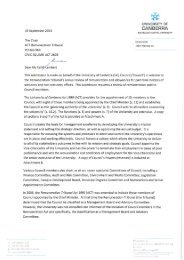
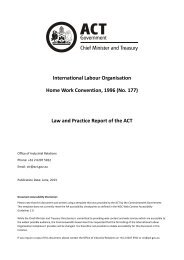


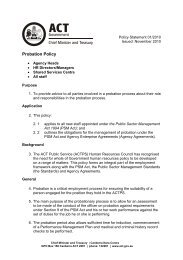

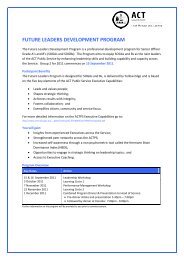

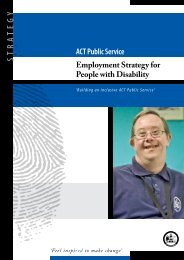
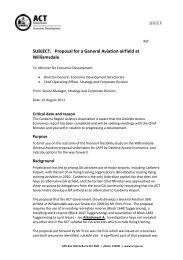
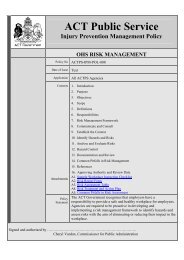
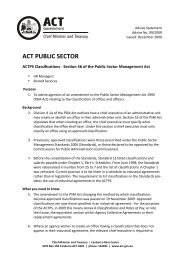
![Teachers Technical and Further Education [ PDF 68KB]](https://img.yumpu.com/34230751/1/184x260/teachers-technical-and-further-education-pdf-68kb.jpg?quality=85)
